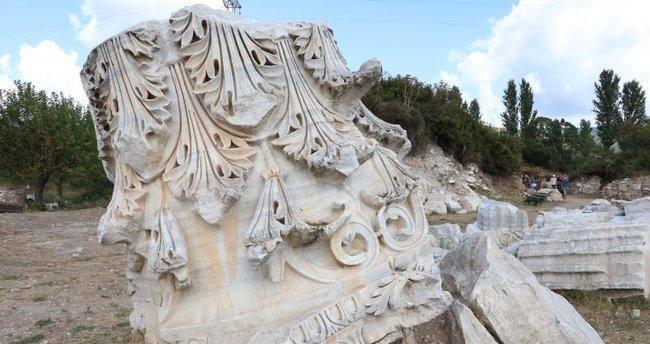
The excavations work at the Temple of Hadrian in the ancient city of Kyzikos, located in the skirts of Kapıdağ Mountain in the Erdek district of the northwestern province of Balıkesir, which resumed on July 2, have unearthed many stone objects in pieces.
Headed by the Bandırma Onyedi Eylül University Department of Humanities and Social Sciences academic Professor Nurettin Koçhan, the excavation team is working in the temple, which takes its name from the Roman emperor Hadrian.
The temple is estimated to be 116 meters in length and 62 meters in width, which is as big as the Ephesus’ Artemis and Didim’ Apollo temples.
The column headings of the temple are 2.49 meters in height, which makes them the highest among the similar temples, Koçhan told the state-run Anadolu Agency. Stating that the construction of the temple could not be completed, Koçhan said, “There was probably an agora just north of the temple. In 166, the philosopher Aristides made a speech in this agora and said, ‘You built such a big temple that it took the place of the mountains. Sailors know the cities from the mountains, but your city is known by the temple.’
The temple had a magnificent structure. The decorations in the temple were painted with red, blue and gold gilding. During the excavations we conducted here, we found the head parts of the relief belt, and we saw gilded paint on the hair of a woman’s head. The roof tiles of this place were made of marble. It was such a monumental building but its most important misfortune was that it had been damaged by frequent earthquakes.
The region came under the rule of the Seljuks in 1085 and during this period, Istanbul started to stand out. In Kyzikos, ports were closed over time and the city began to lose its former importance. That’s why it began to collapse.”
Dimensions of temple also determined
Koçhan said that they found the northwest corner of the temple last year that helped to determine its width. Stating that the pieces they found in the Temple of Hadrian generally belong to the relief belt, Koçhan said, “We always found the sculptures of the temple in pieces, because this place was used as a lime quarry for hundreds of years, they broke the material to make lime. We could find the leftovers from them. This year, we also removed some pieces belonging to the relief belt. We found the body part of a figurine with a shield and parts of the head and arms of other figurines.”
He emphasized that one of the most important finds was the column head they unearthed in 2013.
Pointing out that it is an important finding to determine the exact dimensions of the temple, Koçhan said, “Accordingly, we will try to rebuild the temple this year, at least on a drawing scale.”
It is known that the oldest tribe of Kyzikos, dating back to 5,000 B.C., is the Dolions. The region, where some tribes immigrating from the Aegean and the Balkans settled in 1,200 B.C., continued its existence as the colony of Miletus, one of the most important Ionian cities.
Kyzikos came under Persian rule with the collapse of the rich Lydian state in 546 B.C. The city, which gained independence in 364 B.C., came under the sovereignty of Macedonians after Alexander the Great defeated the Persians in 334. Finally, the region, which was conquered by the Romans, began to lose its importance in the 300s.
Kyzikos, which suffered great damage in two earthquakes in the seventh and eighth centuries, was almost destroyed in the earthquake in 1063.
Archaeological excavations in the ancient city of Kyzikos in the Erdek district of Balıkesir, which is considered one of the important trade centers in history with its three ports, have unearthed important clues about the Hadrian Temple of the city
The pieces of sculptures scattered around the ancient city of Kyzikos are collected and revived by the excavation team.